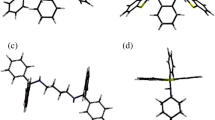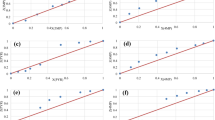Abstract
Roof-shaped host compounds trans-α,α,α′,α′-tetraphenyl-9,10-dihydro-9,10-ethanoanthracene-11,12-dimethanol H3 and trans-α,α,α′,α′-tetra(p-chlorophenyl)-9,10-dihydro-9,10-ethanoanthracene-11,12-dimethanol H6 were assessed for their host potential and selectivity behaviour when presented with single or mixed guest solvents comprising o-xylene, m-xylene, p-xylene and ethylbenzene (o-Xy, m-Xy, p-Xy and EB). H3 included each solvent with 3:1 host:guest ratios, while the ratios preferred by H6 were more varied (4:3, 1:1 and 3:2). More importantly, the selectivity behaviour of these two host compounds was observed to be entirely different: H3 possessed only a very modest preference for o-Xy (37.9–68.2%) when recrystallized from various equimolar binary, ternary and quaternary guest mixtures, while H6 was considerably more selective, preferring m-Xy (the least favoured guest of H3) with selectivities ranging from 57.7 to 91.4% in analogous conditions. The latter result was obtained in o-Xy/m-Xy mixtures and demonstrates that H6 may be employed as a purification tool for mixtures of these two xylenes via host–guest chemistry protocols. A single crystal diffraction experiment on 3(H3)·o-Xy (containing the preferred guest of H3) revealed that the guest was retained in the host crystal by means of a singular (host)m-Ar–H···π(guest) interaction that measured 2.73 Å (148°) as well as numerous other host···guest interactions involving only the aromatic protons of the free host phenyl groups and the guest methyl protons or aromatic carbons and protons (2.20–2.54 Å, 121–125°). Thermal analyses explained the preference of H3 for o-Xy, while these were less informative for the complexes of H6.







Similar content being viewed by others
References
Weber, E., Josel, H.P.: A proposal for the classification and nomenclature of host-guest-type compounds. J. Incl. Phenom. 1, 79–85 (1983)
Weber, E.: Molecular recognition: designed crystalline inclusion complexes of carboxylic acids. J. Mol. Gr. 7, 12–27 (1989)
Izotova, L.Y., Ashurov, D.M., Ibragimov, B.T., Weber, E., Perren, M., Talipov, S.A.: Features of clathrate formation of trans-9,10-dihydro-9,10-ethanoanthracene-11,12-dicarboxylic acid. J. Struct. Chem. 46, S103–S108 (2005)
Czugler, M., Weber, E., Ahrendt, J.: Selective clathrate formation with the new host systems cis- and trans-9,10-dihydro-9,10-ethanoanthracene-11,12-dicarboxylic acid: inclusion properties and X-ray structure of an encapsulated acetic acid dimer. J. Chem. Soc., Chem. Commun. (1984). https://doi.org/10.1039/C39840001632
Weber, E., Hens, T., Gallardo, O., Csöregh, I.: Roof-shaped hydroxy hosts: synthesis, complex formation and X-ray crystal structures of inclusion compounds with EtOH, nitroethane and benzene. J. Chem. Soc., Perkin Trans. 2 (1996). https://doi.org/10.1039/P29960000737
Barton, B., Senekal, U., Hosten, E.C.: Comparing the host behaviour of roof-shaped compounds trans-9,10-dihydro-9,10-ethanoanthracene-11,12-dicarboxylic acid and its dimethyl ester in the presence of mixtures of xylene and ethylbenzene guests. CrystEngComm (2021). https://doi.org/10.1039/D1CE00594D
Fu, T.Y., Scheffer, J.R., Trotter, J.: Structures and photochemistry of inclusion compounds of 9,10-dihydro-9,10-ethenoanthracene-11,12-bis(diphenylmethanol). Acta Cryst. B53, 300–305 (1997)
Sholl, D.S., Lively, R.P.: Seven chemical separations to change the world. Nature 532, 435–437 (2016)
Santos, K., Neto, A.D., Moura, M., Dantas, T.C.: Separation of xylene isomers through adsorption on microporous materials: a review. Braz. J. Pet. Gas 5, 255–268 (2011)
Barton, B., Hosten, E.C., Pohl, P.L.: Discrimination between o-xylene, m-xylene, p-xylene and ethylbenzene by host compound (R, R)-(−)-2,3-dimethoxy-1,1,4,4-tetraphenylbutane-1,4-diol. Tetrahedron 72, 8099–8105 (2016)
Barton, B., de Jager, L., Hosten, E.C.: Minor modifications afford improved host selectivities in xanthenyl-type host systems. CrystEngComm 21, 3000–3013 (2019)
Barton, B., Caira, M.R., de Jager, L., Hosten, E.C.: N, N′-Bis(9-phenyl-9-thioxanthenyl)ethylenediamine: highly selective host behavior in the presence of xylene and ethylbenzene guest mixtures. Cryst. Growth Des. 17, 6660–6667 (2017)
Barton, B., Jooste, D.V., Hosten, E.C.: Synthesis and assessment of compounds trans-N, N’-bis(9-phenyl-9-xanthenyl)cyclohexane-1,4-diamine and trans-N, N’-bis(9-phenyl-9-thioxanthenyl)cyclohexane-1,4-diamine as hosts for potential xylene and ethylbenzene guests. J. Incl. Phenom. Macrocycl. Chem. 93, 333–346 (2019)
Barton, B., Senekal, U., Hosten, E.C.: Compounds N, N’-bis(9-cyclohexyl-9-xanthenyl)ethylenediamine and its thio derivative, N, N’-bis(9-cyclohexyl-9-thioxanthenyl)ethylenediamine, as potential hosts in the presence of xylenes and ethylbenzene: conformational analyses and molecular modelling considerations. Tetrahedron 75, 3399–3412 (2019)
Barton, B., Jooste, D.V., Hosten, E.C.: Behaviour of host compounds 1,2-DAX and 1,2-DAT in the presence of mixed xylene and ethylbenzene guest solvents, and comparisons with their 1,4 host derivatives. J. Incl. Phenom. Macrocycl. Chem. (2021). https://doi.org/10.1007/s10847-021-01065-7
Bruker, A.: APEX2 SADABS and SAINT. Bruker AXS, Madison (2010)
Sheldrick, G.M.: SHELXT–Integrated space-group and crystal-structure determination. Acta Cryst. A71, 3–8 (2015)
Sheldrick, G.M.: Crystal structure refinement with SHELXL. Acta Cryst. C71, 3–8 (2015)
Hübschle, C.B., Sheldrick, G.M., Dittrich, B.: ShelXle: a Qt graphical user interface for SHELXL. J. Appl. Crystallogr. 44, 1281–1284 (2011)
Sykes, N.M., Su, H., Weber, E., Bourne, S.A., Nassimbeni, L.R.: Selective enclathration of methyl- and dimethylpiperidines by fluorenol hosts. Cryst. Growth Des. 17, 819–826 (2017)
Bárcia, P.S., Zapata, F., Silva, J.A.C., Rodrigues, A.E., Chen, B.L.: Kinetic separation of hexane isomers by fixed-bed adsorption with a microporous metal−organic framework. J. Phys. Chem. B 111, 6101–6103 (2007)
Bárcia, P.S., Nicolau, M.P.M., Gallegos, J.M., Chen, B.L., Rodrigues, A.E., Silva, J.A.C.: Modeling adsorption equilibria of xylene isomers in a microporous metal–organic framework. Microporous Mesoporous Mater. 155, 220–226 (2012)
Acknowledgements
Financial support is acknowledged from the Nelson Mandela University and the National Research Foundation (NRF) of South Africa.
Author information
Authors and Affiliations
Corresponding author
Additional information
Publisher's Note
Springer Nature remains neutral with regard to jurisdictional claims in published maps and institutional affiliations.
Supplementary Information
Below is the link to the electronic supplementary material.
Rights and permissions
About this article
Cite this article
Barton, B., Senekal, U. & Hosten, E.C. trans-α,α,α′,α′-Tetraphenyl-9,10-dihydro-9,10-ethanoanthracene-11,12-dimethanol and its tetra(p-chlorophenyl) derivative: roof-shaped host compounds for the purification of aromatic C8H10 isomeric guest mixtures. J Incl Phenom Macrocycl Chem 102, 77–87 (2022). https://doi.org/10.1007/s10847-021-01102-5
Received:
Accepted:
Published:
Issue Date:
DOI: https://doi.org/10.1007/s10847-021-01102-5




